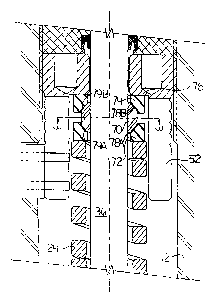Some of the information on this Web page has been provided by external sources. The Government of Canada is not responsible for the accuracy, reliability or currency of the information supplied by external sources. Users wishing to rely upon this information should consult directly with the source of the information. Content provided by external sources is not subject to official languages, privacy and accessibility requirements.
Any discrepancies in the text and image of the Claims and Abstract are due to differing posting times. Text of the Claims and Abstract are posted:
| (12) Patent: | (11) CA 2189608 |
|---|---|
| (54) English Title: | PRESSURE SWITCH WITH INCREASED DEADBAND |
| (54) French Title: | MANOCONTACT A ZONE MORTE ACCRUE |
| Status: | Term Expired - Post Grant Beyond Limit |
| (51) International Patent Classification (IPC): |
|
|---|---|
| (72) Inventors : |
|
| (73) Owners : |
|
| (71) Applicants : |
|
| (74) Agent: | LAMBERT INTELLECTUAL PROPERTY LAW |
| (74) Associate agent: | |
| (45) Issued: | 2004-02-24 |
| (22) Filed Date: | 1996-11-05 |
| (41) Open to Public Inspection: | 1998-05-05 |
| Examination requested: | 1999-09-23 |
| Availability of licence: | N/A |
| Dedicated to the Public: | N/A |
| (25) Language of filing: | English |
| Patent Cooperation Treaty (PCT): | No |
|---|
| (30) Application Priority Data: | None |
|---|
A pressure switch has a housing with an interior bore extending from one end to the other. A rod slidable within the bore and operated by external fluid pressure extends between a piston at one end of the housing and a mechanically operated electrical switch at the other end of the housing. A spring is disposed about the rod between a first stop on the rod and a second stop on the housing. The spring provides resistance against movement of the rod under external pressure. The resistance of the spring to movement is adjusted by a sleeve engaging the spring, with the sleeve threaded into the bore of the housing for movement longitudinally within the housing. A split ring wedged between two other rings resists movement of the rod to longitudinal movement.
Manocontact doté d'un logement avec un alésage intérieur s'étendant d'une extrémité à l'autre. Une tige coulissante dans l'alésage et fonctionnant par pression extérieure de liquide s'étend entre un piston à une extrémité du logement et un commutateur électrique à fonctionnement mécanique à l'autre extrémité du logement. Un ressort est disposé autour de la tige entre une première butée sur la tige et une seconde butée sur le logement. Le ressort fournit une résistance contre le mouvement de la tige sous la pression extérieure. La résistance du ressort au mouvement est réglée par un manche engageant le ressort, le manche étant fileté dans l'alésage du logement pour un mouvement longitudinal dans le logement. Un anneau ouvert est coincé entre les deux autres anneaux résiste au mouvement de la tige vers le mouvement longitudinal.
Note: Claims are shown in the official language in which they were submitted.
Note: Descriptions are shown in the official language in which they were submitted.

2024-08-01:As part of the Next Generation Patents (NGP) transition, the Canadian Patents Database (CPD) now contains a more detailed Event History, which replicates the Event Log of our new back-office solution.
Please note that "Inactive:" events refers to events no longer in use in our new back-office solution.
For a clearer understanding of the status of the application/patent presented on this page, the site Disclaimer , as well as the definitions for Patent , Event History , Maintenance Fee and Payment History should be consulted.
| Description | Date |
|---|---|
| Appointment of Agent Requirements Determined Compliant | 2020-04-22 |
| Revocation of Agent Requirements Determined Compliant | 2020-04-22 |
| Inactive: Expired (new Act pat) | 2016-11-05 |
| Inactive: Office letter | 2007-07-13 |
| Inactive: Office letter | 2007-07-13 |
| Appointment of Agent Request | 2007-07-09 |
| Revocation of Agent Request | 2007-07-09 |
| Grant by Issuance | 2004-02-24 |
| Inactive: Cover page published | 2004-02-23 |
| Inactive: Final fee received | 2003-12-10 |
| Pre-grant | 2003-12-10 |
| Notice of Allowance is Issued | 2003-06-18 |
| Letter Sent | 2003-06-18 |
| Notice of Allowance is Issued | 2003-06-18 |
| Inactive: Approved for allowance (AFA) | 2003-05-28 |
| Inactive: Application prosecuted on TS as of Log entry date | 1999-10-13 |
| Letter Sent | 1999-10-13 |
| Inactive: Status info is complete as of Log entry date | 1999-10-13 |
| All Requirements for Examination Determined Compliant | 1999-09-23 |
| Request for Examination Requirements Determined Compliant | 1999-09-23 |
| Application Published (Open to Public Inspection) | 1998-05-05 |
There is no abandonment history.
The last payment was received on 2003-10-21
Note : If the full payment has not been received on or before the date indicated, a further fee may be required which may be one of the following
Please refer to the CIPO Patent Fees web page to see all current fee amounts.
Note: Records showing the ownership history in alphabetical order.
| Current Owners on Record |
|---|
| ARGUS MACHINE CO. LTD. |
| Past Owners on Record |
|---|
| JAMES RICHARD ELLETT |